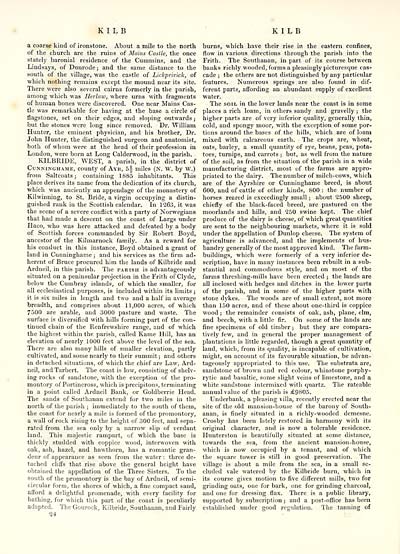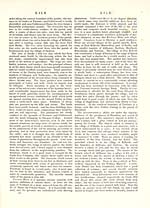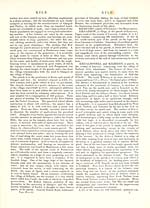Topographical dictionary of Scotland > Volume 2
(32) Page 24
Download files
Complete book:
Individual page:
Thumbnail gallery: Grid view | List view

K I L B
KI LB
a coarse kind of ironstone. About a mile to the north
of the church are the ruins of Mains Castle, the once
stately baronial residence of the Cummins, and the
Lindsays, of Dunrode ; and the same distance to the
south of the village, was the castle of Lickprivick, of
which nothing remains except the mound near its site.
There were also several cairns formerly in the parish,
among which was Herlaw, where urns with fragments
of human bones were discovered. One near Mains Cas-
tle was remarkable for having at the base a circle of
flagstones, set on their edges, and sloping outwards ;
but the stones were long since removed. Dr. William
Hunter, the eminent physician, and his brother, Dr.
John Hunter, the distinguished surgeon and anatomist,
both of whom were at the head of their profession in
London, were born at Long Calderwood, in the parish.
KILBRIDE, WEST, a parish, in the district of
Cunninghame, county of Ayr, 5§ miles (N. W. by W.)
from Saltcoats; containing 1S85 inhabitants. This
place derives its name from the dedication of its church,
which was anciently an appendage of the monastery of
Kilwinning, to St. Bride, a virgin occupying a distin-
guished rank in the Scottish calendar. In 1263, it was
the scene of a severe conflict with a party of Norwegians
that had made a descent on the coast of Largs under
Haco, who was here attacked and defeated by a body
of Scottish forces commanded by Sir Robert Boyd,
ancestor of the Kilmarnock family. As a reward for
his conduct in this instance, Boyd obtained a grant of
land in Cunninghame ; and his services as the firm ad-
herent of Bruce procured him the lands of Kilbride and
Ardneil, in this parish. The parish is advantageously
situated on a peninsular projection in the. Frith of Clyde,
below the Cumbray islands, of which the smaller, for
all ecclesiastical purposes, is included within its limits ;
it is six miles in length and two and a half in average
breadth, and comprises about 11,000 acres, of which
7500 are arable, and 3000 pasture and waste. The
surface is diversified with hills forming part of the con-
tinued chain of the Renfrewshire range, and of which
the highest within the parish, called Kame Hill, has an
elevation of nearly 1000 feet above the level of the sea.
There are also many hills of smaller elevation, partly
cultivated, and some nearly to their summit; and others
in detached situations, of which the chief are Law, Ard-
neil, and Tarbert. The coast is low, consisting of shelv-
ing rocks of sandstone, with the exception of the pro-
montory of Portincross, which is precipitous, terminating
in a point called Ardneil Bank, or Goldberrie Head.
The sands of Southanan extend for two miles in the
north of the parish ; immediately to the south of them,
the coast for nearly a mile is formed of the promontory,
a wall of rock rising to the height of 300 feet, and sepa-
rated from the sea only by a narrow slip of verdant
land. This majestic rampart, of which the base is
thickly studded with coppice wood, interwoven with
oak, ash, hazel, and hawthorn, has a romantic gran-
deur of appearance as seen from the water : three de-
tached cliffs that rise above the general height have
obtained the appellation of the Three Sisters. To the
south of the promontory is the bay of Ardneil, of semi-
circular form, the shores of which, a fine compact sand,
afford a delightful promenade, with every facility for
bathing, for which this part of the coast is peculiarly
adapted. The Gourock, Kilbride, Southanan, and Fairly
24
burns, which have their rise in the eastern confines,
flow in various directions through the parish into the
Frith. The Southanan, in part of its course between
banks richly wooded, forms a pleasingly picturesque cas-
cade ; the others are not distinguished by any particular
features. Numerous springs are also found in dif-
ferent parts, affording an abundant supply of excellent
water.
The soil in the lower lands near the coast is in some
places a rich loam, in others sandy and gravelly ; the
higher parts are of very inferior quality, generally thin,
cold, and spongy moor, with the exception of some por-
tions around the bases of the hills, which are of loam
mixed with calcareous earth. The crops are, wheat,
oats, barley, a small quantity of rye, beans, peas, pota-
toes, turnips, and carrots ; but, as well from the nature
of the soil, as from the situation of the parish in a wide
manufacturing district, most of the farms are appro-
priated to the dairy. The number of milch-cows, which
are of the Ayrshire or Cunninghame breed, is about
600, and of cattle of other kinds, S00 : the number of
horses reared is exceedingly small ; about 2500 sheep,
chiefly of the black-faced breed, are pastured on the
moorlands and hills, and 250 swine kept. The chief
produce of the dairy is cheese, of which great quantities
are sent to the neighbouring markets, where it is sold
under the appellation of Dunlop cheese. The system of
agriculture is advanced, and the implements of hus-
bandry generally of the most approved kind. The farm-
buildings, which were formerly of a very inferior de-
scription, have in many instances been rebuilt in a sub-
stantial and commodious style, and on most of the
farms threshing-mills have been erected ; the lands are
all inclosed with hedges and ditches in the lower parts
of the parish, and in some of the higher parts with
stone dykes. The woods are of small extent, not more
than 150 acres, and of these about one-third is coppice
wood ; the remainder consists of oak, ash, plane, elm,
and beech, with a little fir. On some of the lands are
fine specimens of old timber ; but they are compara-
tively few, and in general the proper management of
plantations is little regarded, though a great quantity of
land, which, from its quality, is incapable of cultivation,
might, on account of its favourable situation, be advan-
tageously appropriated to this use. The substrata are,
sandstone of brown and red colour, whinstone porphy-
rytic and basaltic, some slight veins of limestone, and a
white sandstone intermixed with quartz. The rateable
annual value of the parish is £9S05.
Underbank, a pleasing villa, recently erected near the
site of the old mansion-house of the barony of South-
anan, is finely situated in a richly-wooded demesne.
Crosby has been lately restored in harmony with its
original character, and is now a tolerable residence.
Hunterston is beautifully situated at some distance,
towards the sea, from the ancient mansion-house,
which is now occupied by a tenant, and of which
the square tower is still in good preservation. The
village is about a mile from the sea, in a small se-
cluded vale watered by the Kilbride burn, which in
its course gives motion to five different mills, two for
grinding oats, one for bark, one for grinding charcoal,
and one for dressing flax. There is a public library,
supported by subscription ; and a post-office has been
established under good regulation. The tanning of
KI LB
a coarse kind of ironstone. About a mile to the north
of the church are the ruins of Mains Castle, the once
stately baronial residence of the Cummins, and the
Lindsays, of Dunrode ; and the same distance to the
south of the village, was the castle of Lickprivick, of
which nothing remains except the mound near its site.
There were also several cairns formerly in the parish,
among which was Herlaw, where urns with fragments
of human bones were discovered. One near Mains Cas-
tle was remarkable for having at the base a circle of
flagstones, set on their edges, and sloping outwards ;
but the stones were long since removed. Dr. William
Hunter, the eminent physician, and his brother, Dr.
John Hunter, the distinguished surgeon and anatomist,
both of whom were at the head of their profession in
London, were born at Long Calderwood, in the parish.
KILBRIDE, WEST, a parish, in the district of
Cunninghame, county of Ayr, 5§ miles (N. W. by W.)
from Saltcoats; containing 1S85 inhabitants. This
place derives its name from the dedication of its church,
which was anciently an appendage of the monastery of
Kilwinning, to St. Bride, a virgin occupying a distin-
guished rank in the Scottish calendar. In 1263, it was
the scene of a severe conflict with a party of Norwegians
that had made a descent on the coast of Largs under
Haco, who was here attacked and defeated by a body
of Scottish forces commanded by Sir Robert Boyd,
ancestor of the Kilmarnock family. As a reward for
his conduct in this instance, Boyd obtained a grant of
land in Cunninghame ; and his services as the firm ad-
herent of Bruce procured him the lands of Kilbride and
Ardneil, in this parish. The parish is advantageously
situated on a peninsular projection in the. Frith of Clyde,
below the Cumbray islands, of which the smaller, for
all ecclesiastical purposes, is included within its limits ;
it is six miles in length and two and a half in average
breadth, and comprises about 11,000 acres, of which
7500 are arable, and 3000 pasture and waste. The
surface is diversified with hills forming part of the con-
tinued chain of the Renfrewshire range, and of which
the highest within the parish, called Kame Hill, has an
elevation of nearly 1000 feet above the level of the sea.
There are also many hills of smaller elevation, partly
cultivated, and some nearly to their summit; and others
in detached situations, of which the chief are Law, Ard-
neil, and Tarbert. The coast is low, consisting of shelv-
ing rocks of sandstone, with the exception of the pro-
montory of Portincross, which is precipitous, terminating
in a point called Ardneil Bank, or Goldberrie Head.
The sands of Southanan extend for two miles in the
north of the parish ; immediately to the south of them,
the coast for nearly a mile is formed of the promontory,
a wall of rock rising to the height of 300 feet, and sepa-
rated from the sea only by a narrow slip of verdant
land. This majestic rampart, of which the base is
thickly studded with coppice wood, interwoven with
oak, ash, hazel, and hawthorn, has a romantic gran-
deur of appearance as seen from the water : three de-
tached cliffs that rise above the general height have
obtained the appellation of the Three Sisters. To the
south of the promontory is the bay of Ardneil, of semi-
circular form, the shores of which, a fine compact sand,
afford a delightful promenade, with every facility for
bathing, for which this part of the coast is peculiarly
adapted. The Gourock, Kilbride, Southanan, and Fairly
24
burns, which have their rise in the eastern confines,
flow in various directions through the parish into the
Frith. The Southanan, in part of its course between
banks richly wooded, forms a pleasingly picturesque cas-
cade ; the others are not distinguished by any particular
features. Numerous springs are also found in dif-
ferent parts, affording an abundant supply of excellent
water.
The soil in the lower lands near the coast is in some
places a rich loam, in others sandy and gravelly ; the
higher parts are of very inferior quality, generally thin,
cold, and spongy moor, with the exception of some por-
tions around the bases of the hills, which are of loam
mixed with calcareous earth. The crops are, wheat,
oats, barley, a small quantity of rye, beans, peas, pota-
toes, turnips, and carrots ; but, as well from the nature
of the soil, as from the situation of the parish in a wide
manufacturing district, most of the farms are appro-
priated to the dairy. The number of milch-cows, which
are of the Ayrshire or Cunninghame breed, is about
600, and of cattle of other kinds, S00 : the number of
horses reared is exceedingly small ; about 2500 sheep,
chiefly of the black-faced breed, are pastured on the
moorlands and hills, and 250 swine kept. The chief
produce of the dairy is cheese, of which great quantities
are sent to the neighbouring markets, where it is sold
under the appellation of Dunlop cheese. The system of
agriculture is advanced, and the implements of hus-
bandry generally of the most approved kind. The farm-
buildings, which were formerly of a very inferior de-
scription, have in many instances been rebuilt in a sub-
stantial and commodious style, and on most of the
farms threshing-mills have been erected ; the lands are
all inclosed with hedges and ditches in the lower parts
of the parish, and in some of the higher parts with
stone dykes. The woods are of small extent, not more
than 150 acres, and of these about one-third is coppice
wood ; the remainder consists of oak, ash, plane, elm,
and beech, with a little fir. On some of the lands are
fine specimens of old timber ; but they are compara-
tively few, and in general the proper management of
plantations is little regarded, though a great quantity of
land, which, from its quality, is incapable of cultivation,
might, on account of its favourable situation, be advan-
tageously appropriated to this use. The substrata are,
sandstone of brown and red colour, whinstone porphy-
rytic and basaltic, some slight veins of limestone, and a
white sandstone intermixed with quartz. The rateable
annual value of the parish is £9S05.
Underbank, a pleasing villa, recently erected near the
site of the old mansion-house of the barony of South-
anan, is finely situated in a richly-wooded demesne.
Crosby has been lately restored in harmony with its
original character, and is now a tolerable residence.
Hunterston is beautifully situated at some distance,
towards the sea, from the ancient mansion-house,
which is now occupied by a tenant, and of which
the square tower is still in good preservation. The
village is about a mile from the sea, in a small se-
cluded vale watered by the Kilbride burn, which in
its course gives motion to five different mills, two for
grinding oats, one for bark, one for grinding charcoal,
and one for dressing flax. There is a public library,
supported by subscription ; and a post-office has been
established under good regulation. The tanning of
Set display mode to: Large image | Transcription
Images and transcriptions on this page, including medium image downloads, may be used under the Creative Commons Attribution 4.0 International Licence unless otherwise stated. ![]()
| Gazetteers of Scotland, 1803-1901 > Topographical dictionary of Scotland > Volume 2 > (32) Page 24 |
|---|
| Permanent URL | https://digital.nls.uk/97361513 |
|---|
| Description | Volume II: From Keanlochbervie to Zetland. |
|---|---|
| Attribution and copyright: |
|

